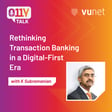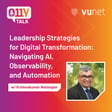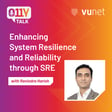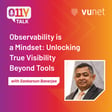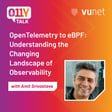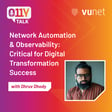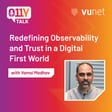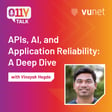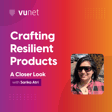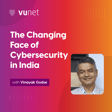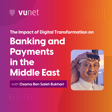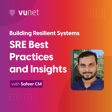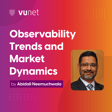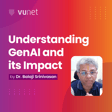Become a Creator today!Start creating today - Share your story with the world!
Start for free
00:00:00
00:00:01

Episode 11 : Building Highly Reliable, Scalable and Observable Fintech Applications
In this episode Bharat and Anuraag Agrawal, Co-Founder and CTO, Fingpay, discuss the evolving field of observability and its critical role in the digital transformation journey of enterprises. With extensive experience across industries, Anuraag highlights the nuances of building reliable, scalable systems and the shift from traditional monitoring to modern observability practices.
Transcript
The importance of user experience in digital transformation
00:00:00
Speaker
I believe user experience is the most important aspect. ah You need to transform the user experience by making it very seamless, intuitive, exciting. I would also say like you know analytics is another important aspect where we need to understand not just a business analytics, business numbers, but also user behavior analytics.
00:00:20
Speaker
business analytics will help you um understand the right data and then it helps you take data driven decisions whereas the user behavior analytics will help you identify how well your digital transformation is working out.
00:00:36
Speaker
And what are the problem areas that you are able to address and where do you need to do any improvements if there is any.
Key factors in business success: Engagement, security, and reliability
00:00:44
Speaker
And and how can you make like know the users engage better. So that's also an important aspect. The third aspect I would recommend is focusing on reliability and security.
00:00:58
Speaker
Security will ensure your business and data are not at risk and reliability ensures that users are able to adapt and you are able to scale. If reliability is not there, users will not use it. So these are three critical um pieces I would like one.
Introducing Anurag Agarwal and his entrepreneurial journey
00:01:27
Speaker
Welcome to a new episode of Observability Talk. Today, I am thrilled to welcome a special guest and also a first for Observability Talk podcast, a senior entrepreneur, Anurag Agarwal. Anurag has been very passionate about solving last mile back a connectivity problem and is a co-founder and CTO of Fingpay.
00:01:48
Speaker
Over the past decade, Arirak has been an active participant in India's startup ecosystem with ventures spanning Pintech, Logistic, Supply Chain, and Board. Apart from Finkpay, he also co-founded Aptibize, which is into highly innovative at futureready logistic solution and Arirak, a warm welcome to Observability Talk. ah Hi, Arirak, a warm welcome to you to Observability Talk. Thank you so much for joining us today.
00:02:17
Speaker
Thanks, Virat. Thanks for having me on this. Yeah, Arrang, you have been a serial entrepreneur and technologist, right? And you have had founded earlier, optimized, and now you're working with ThinkPay. What part of this entrepreneurial journey really excites you the most?
00:02:35
Speaker
See, I enjoy every bit of it, right? And if I have to specify what excites me more is dealing with the microscopic view, wherein you're getting into a lot of details at a ah we decorat microscopic level. And also the telescopic view, where you're looking ahead in the future um for the business, technology, operations, et cetera. So that excites me. I also enjoy the challenges if you consider the 80-20 rule.
00:03:02
Speaker
I like the 20% of the like you know entire thing because mostly the 80% is a slam dunk. So I enjoy challenges. So as part of your founding hat, when you are wearing your founding hat, you would actually be ah doing maybe a spectrum of different roles. right ah You would also be a CTO. At the same time, you will also be maybe VP generic. You will also be a VP QA. ah You will also be looking at architecture and so on.
00:03:34
Speaker
um Is there any specific ah area out of these different areas ah which is much more closer to your heart? ah You forgot to mention like you know the developer role. I really enjoy coding even today. So like you know when I'm stressed out, I like know write some code and it makes me feel better.
00:03:54
Speaker
Right, right. I mean, that is one, one challenge I think my own CTO, Jitesh has. Whenever he feels like, ah okay, he is getting too stressed out, he resorts to start doing some coding, apart from reviews and other things which he gets involved with. ah True. So, ah almost in in in today's time, right, that almost every enterprise is aspiring to become a digital first business. ah You have already founded two such businesses, right, ah from grounds up.
00:04:30
Speaker
And there are a lot of people who are ah looking at creating their own digital first business or their current businesses transforming them themselves to become digital first. ah What would be your top three recommendations ah to such people who are trying to digitally transform themselves today?
Priorities for digital transformation: A discussion with Anurag
00:04:49
Speaker
Yeah, um and I believe user experience is the most important aspect. ah You need to transform the user experience by making it very seamless, intuitive, exciting. ah And I would also say like you know analytics is another important aspect where we need to understand not just the business analytics, business numbers, but also user behavior analytics.
00:05:12
Speaker
Business analytics will help you um understand the right data and then it helps you take data driven decisions. Whereas the user behavior analytics will help you identify how well your digital transformation is working out.
00:05:28
Speaker
And what are the problem areas that you are ah able to address? And where do you need to do any improvements if there is any? And how can you make ah like know the users engage better? So that's also an important aspect. The third aspect I would recommend is ah focusing on reliability and security.
00:05:50
Speaker
Security will ensure your business and data are not at risk and reliability ensures that users are able to adopt and you are able to scale. If reliability is not there, users will not use it. So these are three critical um pieces I would like one.
00:06:07
Speaker
Can you elaborate a little bit more on that user experience part? I am coming ah from the observability platform side, but I just wanted you to go a little bit deeper on in terms of when you say seamless, when you say user exp experience should be good, right? ah Are there any specific metrics?
00:06:26
Speaker
Because we are talking about two separate things. One is very subjective and one could be very objective. right ah I just wanted to deep down on the objective part of it. Subjective is everybody knows that user experience should be good. right People generally say that a good user experience will make sure that you don't have customer chance. But how do you objectively define what that user experience is?
Measuring and improving user experience
00:06:47
Speaker
Correct, so things like, you know, your're um so if it is a very simple form, like, you know, when you're accepting certain amount of input, ah your objective is not to take like, you know, 15 different fees, your objective is to identify what the user is trying to do.
00:07:03
Speaker
which is a goal-based approach rather than a form-based approach. So that is one thing. If you have 15 workflows, how can you like you know cut it down to like you know um fewer workflows, and how can you actually automate the workflow? ah So that is another aspect of user experience.
00:07:22
Speaker
right Right. Right. So this is more to like how we can sort of how they the users can look at the app and get their things done faster. Right. I mean, add with lesser number of inputs. I mean, a lot of things can be auto populated or like you said, certain workflows can be automated and so on.
00:07:43
Speaker
I was also looking at from the performance side of things. Do you have, do you define sort of user experience in terms of certain metrics out there? Yes, absolutely. I think like, you know, see VV in FinTech space, reliability is very, very important, right? And availability is also very, very important. Right. The application is not available if the transaction is not reliable, then like, you know, you would not have users on your platform.
00:08:10
Speaker
And like you just cannot say, like I cannot provide this service is to you today yeah or like you right now. So I think ah even the regulatory bodies actually impresses a lot on the liability aspect. And also, like you know one one additional important aspect is, especially when we are doing financial transactions, you want the financial transactions to be Like, you know, it's success or fail and like and you don't want it to be stuck anywhere in between. that moictic people dread a about right correct And the performance is paramount, right? like oh it's so If you're doing something like, you know, today the user's patience level is like you a very, very low. like you know They are not willing to wait even 5 seconds for a transaction to be completed.
00:08:54
Speaker
And like we when we process transactions, 99% of our transactions are completed in under two seconds. And like you know that that's a key thing today. It's become a hygiene factor.
00:09:06
Speaker
Right, right. I think the last time when we were discussing about some of these things, I was really, really impressed by what you guys have put together internally for ThinkPay, and the kind of observability platform you have created for yourself. That is why I felt like that this I have to ah us to take it to our viewers, right? That they should be aware of that certain thing, like this is also being done ah within the ecosystem and industry, right?
00:09:32
Speaker
um People generally say right that there are two ways to build a platform. right You can be an architect, and you can plan your dashboard metrics. You want to measure what you have done before you even start writing a line of code. ah The other part is that like a sort of a gardener where ah you look at what basically has been built, and then you navigate further depending upon where you are trying to go.
00:09:57
Speaker
right up What is your approach when it comes to building an observability platform? right ah Is it like an architect approach where you start very early and then build it along with your application or is it like something which ah you start ah with whatever interesting information you want to have first and then keep growing from there?
Creating observability platforms: Architect vs. gardener approach
00:10:20
Speaker
Right, I don't know the right answer, but like you know what I face as startups, right like we don't have the luxury of time, we have to go to the market, and that's a critical aspect. And then like when we generally follow an iterative approach. right So it's not always possible to have an architect approach, but having said that, like you I personally would capture the events's data events, data elements as much as possible in the system ah as early as possible ah with the architect approach.
00:10:51
Speaker
And we can continuously improve things with time and with the learnings. So that's more of a like in all ah the other approach that you were talking about. So the short answer to your question is, like you know it's a combination of both.
00:11:07
Speaker
Okay, okay. Yeah, yeah so one of the thing what we have realized very recently now, ah that lot of of our ah prospective customers when we are discussing them with them on the observability side, ah at least a lot of people have started looking at it from day one, or maybe day zero.
00:11:27
Speaker
ah that, OK, I am building, let's say, mobile banking application, right which is going to be like almost like a citizen scale application. up And I definitely want to provide the best in user exp experience. right So what is it that I should also do, apart from my banking application, what all other ah things I should do around it, ah which will help me achieve my goals?
Embedded observability and its impact on application development
00:11:51
Speaker
So one of the things which definitely comes up as the what observability thinks we need to break in at at this time and this this is something what we started calling shift left and we also gave it a term called embedded observability as in where you are
00:12:09
Speaker
building your application, at the time you start thinking about observability so you are embedding observability ah into your application itself, right? ah So this basically we we were discussing sometime back about this platform, observability platform we have built, right?
00:12:28
Speaker
ah You as a FinTech would definitely be integrating with a lot of third-party APIs today. right Almost every enterprise today who is trying to be digital first cannot do everything on their own. right So there is always a third-party API is which you need to connect to. How do you make sure that you are able to meet your customer's SLA in such interconnected system where you are dependent on somebody else?
00:12:58
Speaker
Yeah, it's ah it's a challenge for us and also like you know for most of the businesses. ah As you know, likeron we have a homegrown technology to identify issues and like and if there's any problem, ah we know about it. We inform our partners.
00:13:14
Speaker
ah We also can switch automatically to an alternate like you know interface or alternate party. ah But in some cases, we are bound by the regulatory framework. very like you know We cannot switch to alternate parties. So in such cases, like you know ah we notify the partner about the issues and we we try to like minimize the outage.
00:13:39
Speaker
So in terms of like around SLAs, in some cases, um it it may not be possible for us to meet those SLAs. But what I was talking about, the transaction reliability, et cetera, we have addressed that with like you know ah other mechanisms like reconciliation and reversals, et cetera. Right. And how much of this actually ah has ah your observability platform, which you have built internally, has really helped it?
00:14:09
Speaker
ah achieve some logs it it It has helped us like you know quite a bit. Initially, like um the outages would last for a few hours, and now like know they are cut down to a few minutes. That is one um benefit that we have seen. The second biggest benefit that we have seen is it has shielded our tech resources from like you know getting the unnecessary destruction. And that's a big saver, actually.
00:14:37
Speaker
so So, the ability to identify that the problem is on your third-party partner has helped your tech resources to put a lesser time on these problems, which ah gets... Is that what you are... Our tech resources don't even get involved. So, the what we have built is... There is a problem, an observability tool identifies it, and it sends out a notification which plays out very loud on the operation's teams mobile devices, and the people don like you know who to connect with, and they give specific information about the problem, and the partner fixes it, and our tech resources are totally shielded from all of this. Otherwise, like you know the first person to jump in and like you know
00:15:21
Speaker
First thing is you identify what is a problem, then you bring out the logs, then you communicate with the partner, then the you share the logs. All of this is like you know not needed at all. Right, right, right. I mean, identifying the problem, and it is a partner problem itself is a bigger type consuming task, ah which looks like you have been able to handle very well now. ah Very interesting.
00:15:46
Speaker
ah ah So coming to this, again, when we were discussing, right we also discussed that ah you basically have been investing a lot of time and effort afford in building a very good testing setup, including performance testing, stress testing, and so on.
00:16:03
Speaker
ah Along with the observability platform which you have built, how have this sort of ah scale testing or performance testing has helped you making your application highly available?
Enhancing performance through testing and scalability
00:16:15
Speaker
And ah how you identified ah like what exactly needs to be monitored or observed ah in in in these applications?
00:16:25
Speaker
Right. See, our efforts um would have been there. So we have to do the testing anyways. We have to do the quality testing. We have to do the scalability testing. We are right. this And performance testing actually helps us improve the performance significantly. And that actually helps you scale better. like I cannot feel what service is taking. like no Half the time, then you are able to scale double automatically like no without any additional hardware resources.
00:16:51
Speaker
And during that process, we also identified where the like you know um problem areas are and where you should be focusing on the observability and what kind of metrics we need to like know log and like you know what we need to do to like you know observe and trigger the notifications. So it was a tedious, painful process, but we kind of held us in this whole thing.
00:17:17
Speaker
Okay, ah just one other thing on the observability tool part. ah ah and See, one is obviously you have to have a platform, but then you also have to have a culture of observability, right? ah People who are trained on that platform, people who really take the right decisions whenever some of these things happen.
00:17:40
Speaker
how you have been able to marry both of these things together to really have a good platform and the implementation internally. oh I think like we we have been able to manage that to a good extent. And the reason why we have a few tools which are um automated ah reflects that. And and in in my opinion, even the best can be improved. right And we still have the opportunity to do better. And we are striving to do better.
00:18:10
Speaker
yep Okay, and understood. Arunak, you have built your own ah observability platform internally, but I wanted to ask you, I was very, very curious, ah if you have to look at commercially available observability platform, ah what would yeah be your top three or five, three to five or whatever numbers ah you can get care ah as the considerations for ah buying an observability platform?
00:18:39
Speaker
Right. I think like that's it's always better to like you know um buy a platform than reinvent the wheel. That would be like you know my take on it. ah like know What I would look for in the platform is a seamless plug-and-play capability without requiring a lot of customization or further development or any additional integration efforts, whatever right minimum is possible. Like like a plug-and-play, easy. Plug-and-play, yes.
00:19:04
Speaker
Yeah, second, I would say ah you should be able to get near real time notification for incidents so that like you are not wasting time, you're not getting it like you know ah the next day or like an hour later. So that's probably a must have.
00:19:22
Speaker
um And ideally, like you know ah if it can help prevent incident. So you see, I come from takeio background like i a tin with telco telcos where I learned about observability using OSS, CMS, NMS, and then they had something like a self-healing networks. right So if you are able to get that kind of a feature in the observability platform, where it can help prevent the incident automatically, like and fix the problem,
00:19:51
Speaker
That would be like at um ah the aha moment.
00:19:56
Speaker
yeah this This is very interesting actually, you have actually talked about three very critical parts which we ah get to talk, whenever we talk to our prospective customers, I think each of them come out ah in different degrees, right? Some people are worried that okay, can it be fully plug and play, I really do not have resources to ah to to work with you or sit with you and can you do it yourself then without much ah help from our team, right?
00:20:25
Speaker
ah The second is very critical for most of our customers were alerting. ah They are always looking at that it happens very quickly. Like you said, FTTD, mean time to detect a problem should be reduced as much as ah possible. ah But at the same time,
00:20:45
Speaker
they also talk about carried points to me to sort of ah what is the actual problem because there are a lot of alerts which are getting generated but at that point of time if an alert can actually tells me this is the RCA or this is where the problem started.
00:21:00
Speaker
ah ah is very, very critical. So i'd viewed it we basically did a lot of work on the smart outlets, because we felt that that is something which is a very big pain point ah for a lot of our customers, and that they are really looking forward to ah something much more innovative ahda ah on the side. One thing ah which we which I just touched upon, I did not expand on it. Let me ah ask you this.
00:21:29
Speaker
ah ah we we discuss about the culture of observability. ah Is your team, ah ah ah the engineering team or the QA team or the product team, right? Are collectively focused on this, the proactive visibility and continuous improvement, both from end user perspective as well as for performance perspective, right? ah is Is that how you have built the culture of observability internally?
00:21:59
Speaker
I would say like know the culture exists primarily in the engineering team. ah And like you know whatever they're doing, like don they keep that in mind. like it It's kind of ah like a checklist that they have to like you know go through. And one of the important items in the checklist is observability for them. Right. So the product guys will just say, I want this, and this is how I want it. But the engineering guys cannot skip or overlook this part.
00:22:28
Speaker
Okay, okay. ah Just extending this to another conversation which I was having with one of the CTO. This was regarding that when you are building your applications, ah you are already started thinking about how will I observe it. ah Have you also gone ahead and looked at your logs, which is being generated by your application and sort of trying to standardize them and add context? Is that something which ah you have done across your applications? Yeah, we're trying to standardize as much as possible. In some cases, like you know it it is ah there are slight deviations, but like more or less it is kind of a standardized logging that we have.
00:23:13
Speaker
Okay. And has that helped you in, in, so in, in terms of when somebody says that, okay, uh, their transactions are missing or, uh, there was a failure or I mean, apart from metrics, have you really used logs in your observability platform?
00:23:30
Speaker
ah No, no, we we have not used logs in the observability platform. What we have done is like, you know, although we are doing this observability on near real time, and then like we are relying on like some of the data sources, not really the logs. So we're looking at the data sources and we're looking at like know what is happening in the most recent time t and trying to yeah make sense out of it.
00:23:57
Speaker
Okay. Okay. And is this, I am sure because you comes under RBI stuff, right? So there should be some compliance which require you to have some of these logs maintained for log? Yeah, we do. ah We are compliant with like, you know, RBI norms, and we store those logs for like, you know, seven years, 10 years as per the you know guidelines. like So in the data, everything is like, you know, as per the compliance.
00:24:24
Speaker
Okay, that is very interesting because ah a couple of our customer also had a very similar requirement and then they realize that the amount of logs their applications are generating is very, very huge. So storage becomes sort of a problem. How have you solved that problem?
00:24:41
Speaker
So storage, what we do is can we have the logs on the hard storage, like on the real servers for a couple of days. So just in case if we need to analyze deeper for a night problem, or if somebody is asking for logs, banks, or customers, then we have access easy access to them.
00:25:01
Speaker
Then like can we start archiving. First, we archive to like you know a cloud disk. And then like ah after a couple of years, we just put it on our deep storage. And we have the indexing mechanism as to like know what log you need to see for what type of transaction. So the indexation is actually helping us quite a bit.
00:25:27
Speaker
Okay. Okay. So you basically make sure that you have stored the log such a way that it can be restored quickly if at all a requirement comes from RBI or something else.
00:25:38
Speaker
i
00:25:41
Speaker
Okay, okay, this is pretty good because logs has always been challenged for ah most of our customers, right? That one is obviously the unstructured nature of the logs, ah that how do you get interesting information out of it if they if it is not fully structured. And second thing is that how do we store ah it for logger duration for couple eyes purposes or um looking at it if if there are any queries which comes out. Fantastic.
00:26:09
Speaker
ah Aruna, no conversation is complete right without anybody talking about AI, ML, and general AI in general. right ah I wanted to know at Fingpay or in general in your personal time, are you excited about any use cases that you have come across in the payment space ah with AI?
AI in payments: Innovations and fraud prevention
00:26:33
Speaker
Yeah, ah in fact, like it all um we have done a voice-based conversational experience ah to do a payment using Google Home ah device almost six, seven years back, wherein you just say, pay Bharat 1,000 rupees, and it actually real-time transfers 1,000 rupees to Bharat's account.
00:26:55
Speaker
And I have a video, if you want to see, like if I can share the video with you. like it so and a seven year old we all um and like ah It has the bank i account statement, which shows you ah what your statement is before I speak to the Google Home. And then after I tell Google Home, instantly, like you know within a matter of couple of seconds, you will see the balance of data.
00:27:18
Speaker
So that was one use case. Other use cases that I have come across are the AI engine is suggesting me while making a payment to use the right instrument for maximizing the benefits. Like, you know, okay, you use this and you will get so much of benefit. So many points or cashbacks or discount, or like, you know, you haven't used this card enough to like, you know,
00:27:41
Speaker
meet your minimum goal. So that's another use case that I've come across. ah Pretty interesting. um And then there was one more system, which I'm very well aware of is a spin management system, wherein i know it analyzes the patterns and identifies and cause anomalies.
00:27:59
Speaker
It's a corporate ri map and system. yeah very too At Finkpay, do you have any sort of ah um ah fraud ah related thing because you are obviously in line in tragic sense. Do you provide such a thing within your services? Yes, yes. So in fact, we use quite a bit of that. And we have been successful in containing the frauds and chargebacks significantly on our platform.
00:28:26
Speaker
And yeah we we like um after the implementation, we have seen the frauds coming down by almost 90%. Wow, 90%. That is interesting. So I always felt that fraud is one place where ah there are a lot of pattern recognition, that there are a lot of this AI can really help identify whether a given transaction could be a fraud, right? I mean at least you can add like what maybe ICICI or some other companies does, right? That they add the second ah factor authentication or maybe a third factor authentication depending upon but from where you are making the transaction and what transactions you have made just before that or after that and so on. So that way I felt that AI can definitely be a ah very useful instrument for fraud sort of the sort of use cases.
00:29:18
Speaker
Very interesting and ah anything on the JAI side or anything which you are looking at it ah from observability perspective like AI, ML or JAI use it observability.
AI's role in enhancing observability tools
00:29:32
Speaker
I think like know ah AI should take the observability platforms to the next level. ah Right now, I think there's quite a bit of work that you need to do. like it all ah So I'm telling from my experience, there's quite a bit of development effort that goes in to build such a tool. And using AI, I think you give access to the raw data, the like you know events, and it should be able to summarize and like know do that like not much so ah More efficiently. So and then other thing is again today
00:30:08
Speaker
and see some Sometimes, again, you need to bring in the engineering resources to um figure out the pattern. but right ah So if there is a question that comes from the business of product team, like, ah hey, what happened here? or like And why is this happening? So there's an engineering brain that is at work for like you know maybe a few minutes or a few hours. The Gen AI can probably like can take away that load. So that's another result I can foresee.
00:30:36
Speaker
ah very Very, very true. The co-pilot, which like Microsoft and other people have started pushing it for, augmenting the engineers, writing quotes and so on. I think what you said the ah from identifying a particular problem based on whatever data is coming in, could definitely be one place where it can help. Because ah but on the other side, we are already havocs above these things.
00:31:01
Speaker
ah I just wanted to take it a little bit further to ask you. because this is something which you are working, and because you created your own observability platform, so what do you have a view in terms of what do you think, whether this is something which is useful. ah So what we are looking at now is that once you have identified the RCA, sort of probable RCA, that okay, a problem could have happened because of maybe two or three specific ah ah challenges in your environment. It could be infrastructure, or it could be
00:31:37
Speaker
application it could be third party, right? ah What we have been thinking is that once you have identified the RCA, um there is a very high chance that this problem would have happened earlier. And somebody would have already solved this problem and would have most probably stored their method of solving that or steps of solving that problem, right?
00:32:00
Speaker
ah So, what we have started looking at is, can we get into the recommendability part of it, where ah ah rather than just giving an RCA and leaving it there, can we go ahead and say that if you believe that the the problem RCA 1 is a challenge, then you go ahead and look at these recommendations, which maybe somebody else has used to solve that problem.
00:32:23
Speaker
Uh, so maybe it could be as simple as, okay, restart a service because CPU client has gone up, right? This, this is also a sort of recommendation ah that it could be something like what you said, right? That moving to, uh, because SLA of a.
00:32:38
Speaker
provider is not good enough, let me move to another one. ah So, do you think such a thing would be very useful? And this is coming in like a jerry eye form. a abluci addict If you are suggesting a remedy, if there is further action needed to be taken, the remedy will actually help. It is helping cut down the time. rate cut down the time to like, you know, identifying the solution. And I would go even one step further, what I was talking about earlier, like, you know, self-healing networks are self-healing solutions. So if you take it further, like, you know, if you have that capability varying, like, you know, you're able to
00:33:15
Speaker
trigger something and then, as you said, restart the server. Why can't the Gen AI do that on its own? Why do you need to involve a human being? hey And if you need to change the code or change something, the remaining would actually cut down quite a bit of time. So the task to fix a problem can come down from like you know weeks to days or hours.
00:33:38
Speaker
Yeah, so that that's a very interesting space, right? We should talk about self-healing or automation. ah Have you ah attempted it in your environment? Yeah, we we do have like, you know, so the he switching to another vendor is a selfie solution, right? Kind of. And also, like again, we have um we have implemented the pre-start of a server, like, you know, based on yeah click on the observability. So what we do is we first cut it out from the load balancer, and then like a we restart the server. And cutting it out and restarting, both these steps are fully automated.
00:34:17
Speaker
yeah are doing Very interesting, very interesting. And this sort of automation has maybe reduced your FTTD, FTTR by what margin? I mean, if I, if you have some numbers, now it doesn't charge the numbers, but like, you know, see in terms of reliability, it has improved the reliability quite a bit. So the fallouts in the transactions are almost like, you know, zero, like, you know, we,
00:34:44
Speaker
We don't see like um in the chargebacks team is kind of like you um getting bored, I would say. they You may have to fight something else for them, right? You're assigning them to some other task.
00:35:00
Speaker
Very nice. I was really impressed with whatever I saw some time back. and ah i mean ah Congratulations to you and your team to to make that happen because it does take a lot of effort because we have been implementing observability for a lot of our customers. right The kind of complex environment we have implemented observability in And the the kind of varied ah ah infrastructure components, applications, web servers, databases we have seen, right? And ah stitching all this together is very, very complex and time consuming.
00:35:36
Speaker
i and i be youre you your ability to i rat identify which transition is failing and how fast ah you are able to identify is really compatible. So I think you guys have done a fantastic job in building such a platform internally.
Personal insights and storytelling in entrepreneurship
00:35:53
Speaker
ah the The last question ara ah which we generally ask all of our hosts because ah everybody has been a master of their ah domain. ah Sort of ah to get a view in terms of what you would recommend.
00:36:13
Speaker
what is it that is your favorite book ah which you always go back to or putting it another way ah that what are those, what are two books which you usually recommend to to people? but Yeah, like you know that's ah that's a difficult answer. um I would want to say ah So like let me put it this way, right? like i would I would have said Bhagavad Gita, but like you know. um But see, like i'm more than that, I think, I'm not sure if this is what you're looking for, but thanks to my parents, as a child, I have tons of storybooks, like Amachit Katha, Tanama, and a few more. And those books helped me understand things like the truthfulness, honesty, patience, perseverance, courage, gratitude,
00:37:04
Speaker
And a few more things like you know that actually help you ah be your character as you provide. And I would recommend everyone to invest time with their kids by sharing such stories and bring the best out of them. That's what I would probably say. I don't know if that's what you were looking for.
00:37:24
Speaker
No, I mean whatever has saved your journey so far or what will shape your journey going forward ah is what I was thinking because when you're talking to somebody who has really done ah something interesting, right, people want to really know what is the thought process behind it and how they have reached where they have reached ah and so sort of what has inspired them.
00:37:49
Speaker
So we thought maybe ah books would be one, definitely one medium, which really inspire people. And your answer is ah ah very right ah in terms of how you become a complete ah package, right, in terms of what whatever you have done.
00:38:07
Speaker
So this is very, very interesting. So yeah, I mean, thank you so much, Arurag, for your time. It was very lovely talking to you. Great insight. I'm sure it will be very helpful for a lot of people who are trying to build something themselves, as well as who are looking out for help with companies like us who can provide an observability platform for their application.
00:38:35
Speaker
ah Really appreciate your time. Thank you so much for joining us today. Thank you, Bharat. It was wonderful to be here. Hope you find my discussion with Anurag insightful. If you did, please consider sharing it with your colleagues.
Closing and call to action
00:38:50
Speaker
You can learn more about ThinkPay at www.thinkpay.co.in. For more information about ViewNet Systems, please visit us at www.viewnetsystems.com. Thank you.
